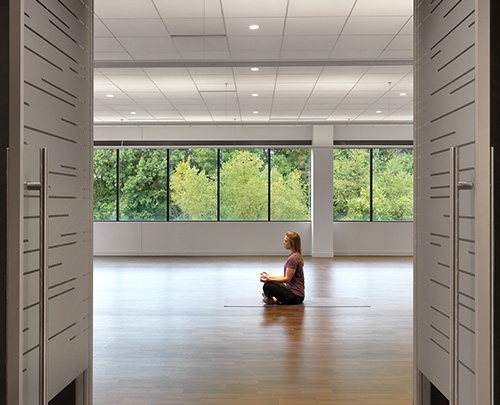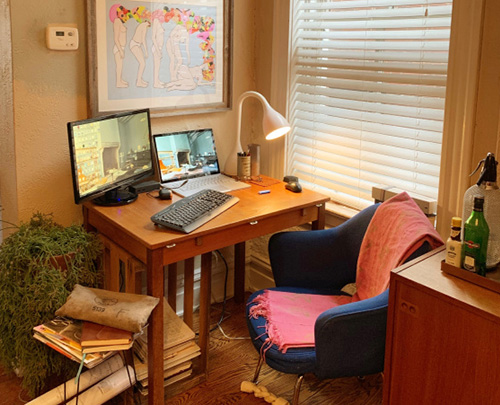In this new working from home scenario, I have witnessed many colleagues working from their dining room chairs or sofas. While the adaptability of our technology has allowed us to work from home, the adaptability of our physical workspace and work tools have lagged behind. If we do not have the luxury of a dedicated home office, our interim desks often lack space and adjustability. More importantly, most households do not have commercial grade ergonomic task chairs or sit-to-stand accessories found in well-designed workplaces. In an effort to cope with what we have, we are forgoing good ergonomics and opening the door for musculoskeletal issues.
Ergonomics is the science and practice of fitting the workplace to the user’s need. In general, experts suggest that “both prolonged standing and prolonged sitting should be considered, and that occupants should alternate seated and standing positions throughout the day.” The Movement concept in the WELL Building Standard V.2 promotes mobility and physical activity while discouraging sedentary behaviors.
Feature V02 Visual and Physical Ergonomics requires projects to provide basic ergonomic furnishings for desk- and standing-based workstations.
Feature V07 Active Furnishings furthers the ergonomic conversation and sets a requirement for the percentage of sit-stand workstations required. The standard also touches on “dynamic workstations” which include treadmill and bicycle desks. As a side note… in web calls so far, I have yet to see someone on a treadmill.
Feature V10 Enhance Ergonomics incorporates the services of a professional ergonomic consultant to offer their expertise twice a year to all employees.
When working from home, we should take time to tune into our body in terms of ergonomics. Ergonomic experts teach that “the next posture is best posture,” which means keep moving and keep changing positions. Several apps and tools offer support on how to design a work from home set up that is kind to your spine. The app from EWI Works is a great education tool that can help diagnose bad ergonomics and give options to improve. EWI also offers a free checklist to help review your workspace.
The beauty of working from home is that we have the freedom to get up, take a walk and work from a different room, chair or position. The autonomy of working from home can offer benefits for ergonomics and posture that we can bring back into the traditional workplace.
How can we incorporate ergonomics into our work from home set ups?
- Employ an independent keyboard and mouse if working from laptop.
- Use earbuds for hands free posture in video and audio calls.
- Look at modifications to your current work set-up. Roll up towel/pillow for lumbar support if working from dining chair; add cushions to the seat to improve the sit. Use boxes to raise your laptop or monitors to eye level.
- If you can, move around the house, take a call on the sofa; answer emails in an armchair or even a hammock. Even better, have a walking meeting. Remember: your next posture is your best posture.
- Take micro-breaks from sitting, even 30-60 seconds of movement can reset your posture. Utilize health tracker watches or free apps like Stand up! The Work Break Timer or Randomly RemindMe. Desktop apps like Awareness, Healthier: Break Reminder and Time Out are available as well.


